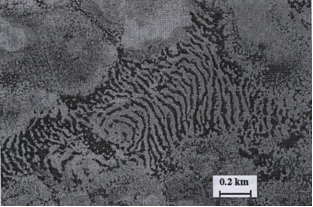Mechanisms of Species Diversity Change in Stressed Environments
Ehud Meron
The impacts of environmental changes on species diversity, and thus on ecosystem function and stability, is a central topic of current ecological research. While such changes may independently affect animal and plant species, plants standout in being primary producers; by storing solar energy in chemical compounds they constitute the basal trophic level of the food chain that animal species, including humans, depend on. Plant communities respond to environmental changes at different scales. At the landscape scale, where symmetry breaking vegetation patterns appear (Fig. 1), a transition from one pattern state to another may take place (Animation 1). At smaller, single-patch scales, environmental changes may affect inter- and intra-specific plant interactions. Using a mathematical modeling approach, we developed a theory of plant communities in water limited system, and are currently using it to highlight mechanisms of species diversity change in response to climate changes and disturbances. Special attention is given to mechanisms that involve different levels of organization, e.g. mechanisms by which pattern transitions at the landscape level affect plant interactions and species richness at the single-patch level.

Figure 1: Aerial photograph of vegetation bands on hill slopes in Niger. Reprinted from C. Valentin, J. M. d'Herbes, and J. Poesen, Catena 37, 1 (1999), ©1999.
Animation 1: Model simulation showing a transition from a banded vegetation pattern to a spotted pattern induce by a local clear-cut disturbance. Downhill direction is to the right. Produced by Erez Gilad.
Can't see the movie? here it is in animated GIF.
Further reading:
- Patterns of Green in the Desert Brown (Phys. Rev. Focus article, 2001)
- Vegetation patterns and desertification (Newman Information Center)
- Ecosystem engineers, a missing link in exploring biodiversity: A pattern-formation approach (JSMF research award, 2003)
- Symmetry Breaking Patterns and Eco-Complexity (PhysicaPlus, Online Magazine of the Israel Physical Society, Issue 3, 2004)
See also Recent Publications link in http://www.bgu.ac.il/~ehud